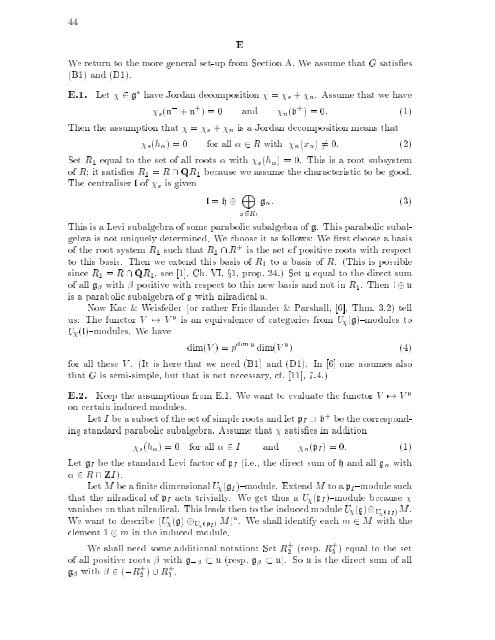subregular nilpotent representations of lie algebras in prime ...
subregular nilpotent representations of lie algebras in prime ...
subregular nilpotent representations of lie algebras in prime ...
Create successful ePaper yourself
Turn your PDF publications into a flip-book with our unique Google optimized e-Paper software.
44<br />
E<br />
We return to the more general set-up from Section A. We assume that G satis es<br />
(B1) and (D1).<br />
E.1. Let 2 g have Jordan decomposition = s + n. Assume that we have<br />
s(n , + n + )=0 and n(b + )=0: (1)<br />
Then the assumption that = s + n is a Jordan decomposition means that<br />
s(h )=0 for all 2 R with n(x ) 6= 0. (2)<br />
Set R1 equal to the set <strong>of</strong> all roots with s(h ) = 0. This is a root subsystem<br />
<strong>of</strong> R; it satis es R1 = R \ QR1 because we assume the characteristic to be good.<br />
The centraliser l <strong>of</strong> s is given<br />
l = h<br />
M<br />
2R1<br />
g : (3)<br />
This is a Levi subalgebra <strong>of</strong> some parabolic subalgebra <strong>of</strong> g. This parabolic subalgebra<br />
is not uniquely determ<strong>in</strong>ed. We choose it as follows: We rstchoose a basis<br />
<strong>of</strong> the root system R1 such that R1 \ R + is the set <strong>of</strong> positive roots with respect<br />
to this basis. Then we extend this basis <strong>of</strong> R1 to a basis <strong>of</strong> R. (This is possible<br />
s<strong>in</strong>ce R1 = R \ QR1, see [1], Ch. VI, x1, prop. 24.) Set u equal to the direct sum<br />
<strong>of</strong> all g with positive with respect to this new basis and not <strong>in</strong> R1. Then l u<br />
is a parabolic subalgebra <strong>of</strong> g with nilradical u.<br />
Now Kac & Weisfeiler (or rather Friedlander & Parshall, [6], Thm. 3.2) tell<br />
us: The functor V 7! V u is an equivalence <strong>of</strong> categories from U (g){modules to<br />
U (l){modules. We have<br />
dim(V )=p dim u dim(V u ) (4)<br />
for all these V . (It is here that we need (B1) and (D1). In [6] one assumes also<br />
that G is semi-simple, but that is not necessary, cf. [11], 7.4.)<br />
E.2. Keep the assumptions from E.1. We want toevaluate the functor V 7! V u<br />
on certa<strong>in</strong> <strong>in</strong>duced modules.<br />
Let I be a subset <strong>of</strong> the set <strong>of</strong> simple roots and let pI b + be the correspond<strong>in</strong>g<br />
standard parabolic subalgebra. Assume that satis es <strong>in</strong> addition<br />
s(h )=0 for all 2 I and n(pI) =0: (1)<br />
Let gI be the standard Levi factor <strong>of</strong> pI (i.e., the direct sum <strong>of</strong> h and all g with<br />
2 R \ ZI).<br />
Let M be a nite dimensional U (gI){module. Extend M to a pI{module such<br />
that the nilradical <strong>of</strong> pI acts trivially. We get thus a U (pI){module because<br />
vanishes on that nilradical. This leads then to the <strong>in</strong>duced module U (g) U (pI)M.<br />
We want to describe (U (g) U (pI) M) u .We shall identify each m 2 M with the<br />
element 1 m <strong>in</strong> the <strong>in</strong>duced module.<br />
We shall need some additional notation: Set R +<br />
2<br />
(resp. R+ 3 ) equal to the set<br />
<strong>of</strong> all positive rootswith g, u (resp. g u). So u is the direct sum <strong>of</strong> all<br />
g with 2 (,R +<br />
2 ) [ R+ 3 .

















